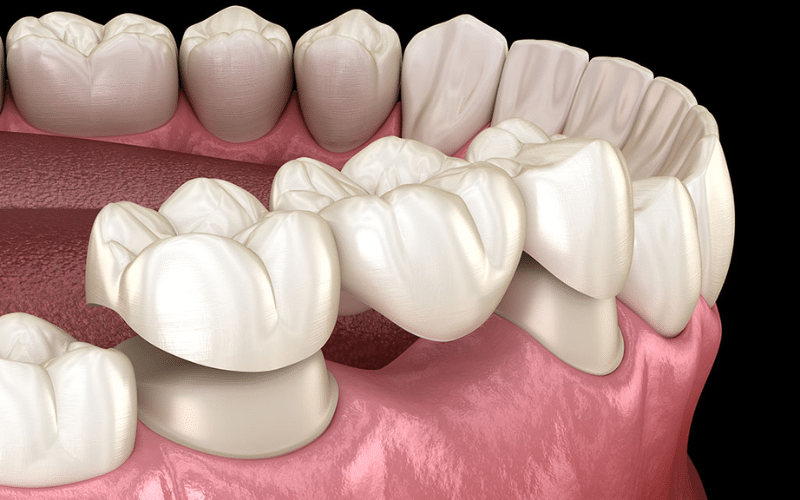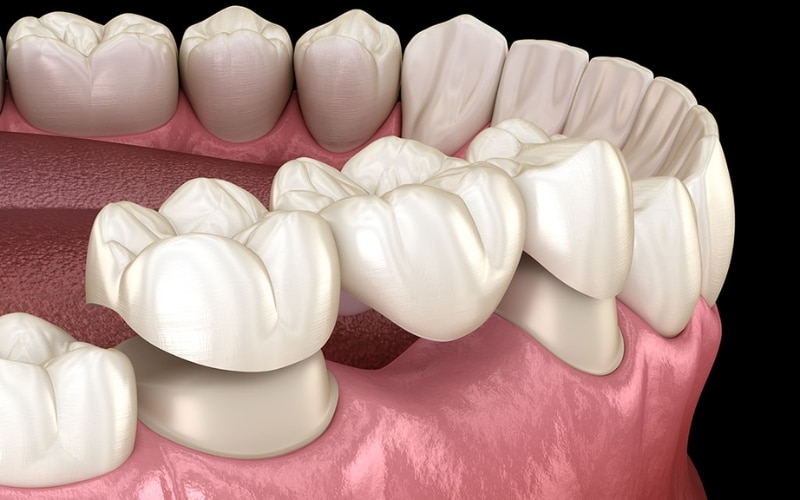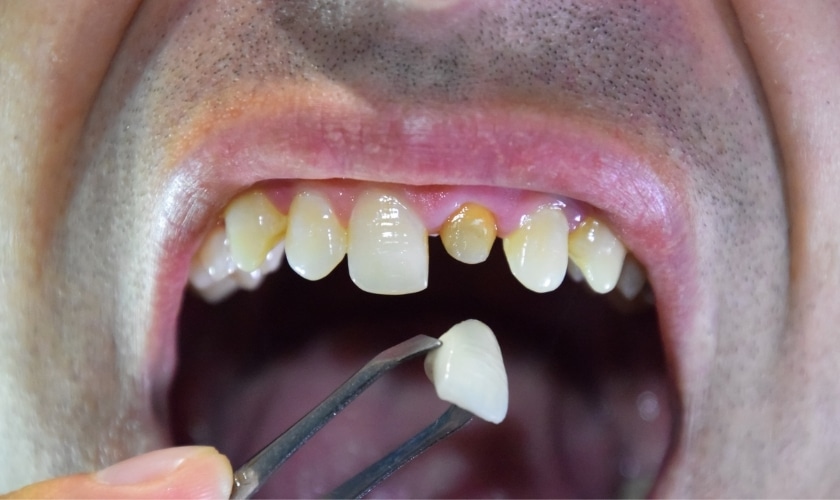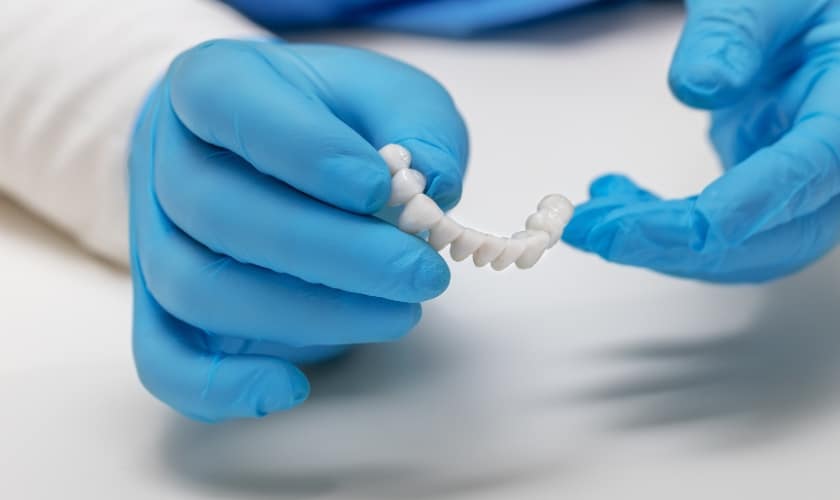
A healthy smile isn’t just about aesthetics—it plays a crucial role in chewing, speaking, and maintaining the overall balance of your oral health. But what happens when teeth are damaged, weakened, or missing? Dental bridges and crowns are useful in this situation.
Unlike some typical blogs, this guide takes you on an engaging journey through the world of crowns and bridges—how they work, when they’re needed, and how they not only restore your smile but also rejuvenate its function. Let’s dive into the world of dental restoration with a fresh perspective.
The Dual Role of Crowns and Bridges: Why They Matter?
Dental crowns and bridges are often talked about as if they’re two different solutions for separate issues. While they do serve distinct purposes, they share a common goal: restoring your teeth to full functionality while enhancing your smile.
Here’s a quick breakdown:
- Crowns: Designed to cover damaged or weak teeth, providing protection and strength.
- Bridges: Fill the gap left by one or more missing teeth using neighboring teeth or implants for support.
Together, they restore both the appearance and the function of your teeth, allowing you to bite, chew, and smile confidently.
Crowns: The Saviour for Damaged Teeth
A dental crown is like a cap that fits over your tooth. If your tooth is weakened by decay, cracked, or after a root canal treatment, it needs extra support. A crown acts as a protective shield, preventing further damage and restoring the tooth’s shape and strength.
When Do You Need a Crown?
There are several situations where a crown is the best solution for your dental health:
- Severe Tooth Decay: When a filling isn’t enough, a crown restores the tooth’s full structure.
- Cracked or Broken Teeth: If a tooth is too weak to repair with bonding, a crown covers and protects it.
- Root Canal Therapy: After a root canal, the tooth can become brittle. A dental crown offers vital defense.
- Cosmetic Issues: Crowns can also enhance the appearance of misshapen or discolored teeth.
Types of Dental Crowns
Crowns come in different materials, each suited for specific purposes. The main types include:
- Porcelain Crowns: Best for front teeth due to their natural appearance.
- Metal Crowns: Strong and durable, typically used for molars.
- Porcelain-Fused-to-Metal: Combines the strength of metal with the natural look of porcelain.
- All-Resin Crowns: Less expensive but not as durable, often used as temporary crowns.
Bridges: Filling The Gap for a Complete Smile
A missing tooth can do more than just leave a gap in your smile—it can also affect your bite, lead to bone loss, and shift your remaining teeth. The purpose of dental bridges is to ‘bridge’ this gap by attaching to nearby teeth or dental implants.
How Do Dental Bridges Work?
There are 2 primary components to a dental bridge:
- Abutment Teeth: These are the teeth or implants on either side of the gap. They serve as the anchor points for the bridge.
- Pontic (False Tooth): This is the replacement tooth that fills the gap, creating a natural-looking smile.
When Should You Consider a Dental Bridge?
- Missing Teeth: If you’re missing one or more teeth, a bridge prevents neighboring teeth from shifting.
- Difficulty Chewing: A bridge restores your ability to chew food properly.
- Speech Issues: Missing teeth can affect your pronunciation. Bridges restore natural speech patterns.
- Aesthetic Concerns: Bridges fill the gap in your smile, helping you regain confidence.
The Crowns and Bridges Procedure: What To Expect?
Understanding the process for both crowns and bridges can ease any anxiety you might feel. Here’s what typically happens:
For Crowns
- Initial Exam and Tooth Preparation: Our certified dentist in Cedar Park, TX, will examine your tooth and prepare it by reshaping it to fit the crown.
- Impressions and Temporary Crown: Impressions are taken to create a custom crown. A temporary crown is placed while you wait for the permanent one.
- Final Crown Placement: The custom crown is fitted and bonded to your tooth, restoring its function and appearance.
For Bridges
- Preparation of Abutment Teeth: The teeth or implants on either side of the gap are prepared for crowns, which will anchor the bridge.
- Impression and Temporary Bridge: Impressions are made for a custom bridge, and a temporary one is placed in the meantime.
- Final Bridge Placement: The permanent bridge is fitted and cemented, filling the gap and restoring your smile.
The Lifespan of Crowns and Bridges: How Long Do They Last?
With proper care, crowns and bridges can last a decade or longer, but they’re not immune to wear and tear. Just like natural teeth, crowns and bridges require good oral hygiene and routine dental check-ups.
How To Extend The Lifespan?
- Brush and Floss Daily: Pay special attention to the area where the crown or bridge meets your gums.
- Avoid Hard Foods: Biting down on ice or hard candies can damage your crown or bridge.
- Use a Night Guard: If you grind your teeth, a night guard can protect your restoration from excessive wear.
Crowns vs. Bridges: Which One Is Right for You?
While both crowns and bridges have their specific uses, how do you know which one you need? Here’s a quick comparison:
- Crowns: Best for individual teeth that are damaged but still present. If you have a tooth that needs reinforcement or cosmetic improvement, a crown is the way to go.
- Bridges: Ideal for filling gaps caused by missing teeth. If you’ve lost a tooth and want to restore your smile and bite without getting an implant, a bridge is the right solution.
Myth-Busting: Common Misconceptions About Crowns and Bridges
Many patients have preconceived notions about crowns and bridges that aren’t necessarily true. Let’s clear up a few myths:
- Myth 1: Crowns and Bridges Are Only for the Elderly.
- Reality: Patients of any age may need crowns or bridges due to decay, injury, or tooth loss.
- Reality: Patients of any age may need crowns or bridges due to decay, injury, or tooth loss.
- Myth 2: Crowns and Bridges Are Painful to Get.
- Reality: The procedures for crowns and bridges are relatively simple and performed under local anesthesia, minimizing discomfort.
- Reality: The procedures for crowns and bridges are relatively simple and performed under local anesthesia, minimizing discomfort.
- Myth 3: Bridges Don’t Look Natural.
- Reality: Modern dental bridges are custom-made to match the color and shape of your natural teeth, providing a seamless look.
Whether you need a crown to protect a weak tooth or a bridge to replace missing teeth, both treatments offer long-lasting solutions for restoring not just the look but the function of your smile.
Crowns shield damaged teeth, while bridges ensure gaps are filled with durable, natural-looking replacements. Our dentist in Cedar Park, TX, will guide you through the process, ensuring you receive the best treatment for your dental needs.
Taking care of crowns and bridges involves the same principles as caring for natural teeth—good oral hygiene, regular dental check-ups, and protecting them from excessive force. Your smile and dental health deserve it!




